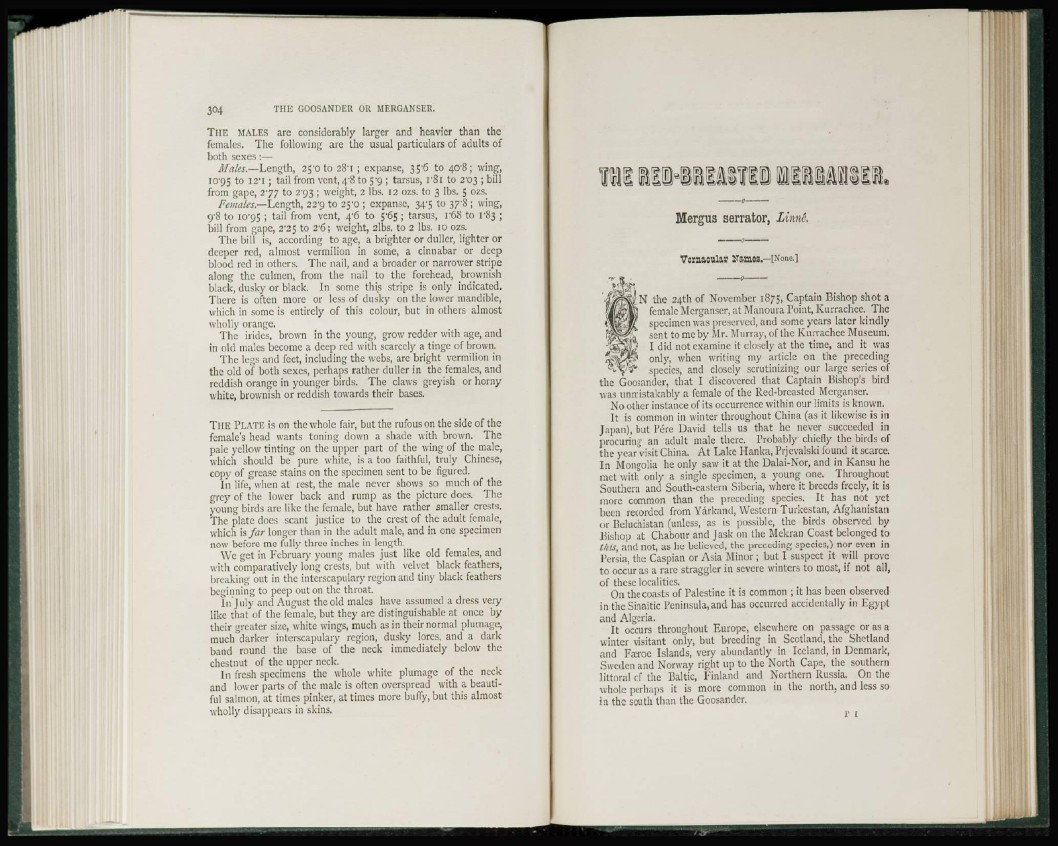
THE MALES are considerably larger and heavier than the
females. The following are the usual particulars of adults of
both sexes :—
Males.—Length, 25-0 to 2S'i ; expanse, 35*6 to 40*8; wing,
J.0'95 to I2-I ; tail from vent, 48 to 5-9 ; tarsus, iSr to 2-03 ; bill
from gape, 277 to 2'93 ; weight, 2 lbs. 12 ozs. to 3 lbs. 5 ozs.
Females.—Length, 22"9 to 25'o ; expanse, 34-5 to 37"8 ; wing,
9"8 to lO'95 ; tail from vent, 4'6 to 5-65 ; tarsus, i*68 to 1-83 ;
bill from gape, 2*25 to 2-6; weight, 2lbs. to 2 lbs. 10 ozs.
The bill is, according to age, a brighter or duller, lighter or
deeper red, almost vermilion in some, a cinnabar or deep
blood red in others. The nail, and a broader or narrower stripe
along the culmcn, from the nail to the forehead, brownish
black, dusky or black. In some this stripe is only indicated.
There is often more or less of dusky on the lower mandible,
which in some is entirely of this colour, but in others almost
wholly orange.
The irides, brown in the young, grow redder with age, and
in old males become a deep red with scarcely a tinge of brown.
The legs and feet, including the webs, are bright vermilion in
the old of both sexes, perhaps rather duller in the females, and
reddish orange in younger birds. The claws greyish or horny
white, brownish or reddish towards their bases.
THE PLATE is on the whole fair, but the rufous on the side of the
female's head wants toning down a shade with brown. The
pale yellow tinting on the upper part of the wing of the male,
which should be pure white, is a too faithful, truly Chinese,
copy of grease stains on the specimen sent to be figured.
In life, when at rest, the male never shows so much of the
grey of the lower back and rump as the picture does. The
young birds arc like the female, but have rather smaller crests.
The plate does scant justice to the crest of the adult female,
which is far longer than in the adult male, and in one specimen
now before me fully three inches in length.
We get in February young males just like old females, and
with comparatively long crests, but with velvet black feathers,
breaking out in the interscapular)- region and tiny black feathers
beginning to peep out on the throat.
In July and August theold males have assumed a dress very
like that of the female, but they arc distinguishable at once by
their greater size, white wings, much as in their normal plumage,
much darker interscapulary region, dusky lores, and a dark
band round the base of the neck immediately below the
chestnut of the upper neck.
In fresh specimens the whole white plumage of the neck
and lower parts of the male is often overspread with a beautiful
salmon, at times pinker, at times more buffy, but this almost
wholly disappears in skins.
NSMRBASltO QtMABIVft
Mergus serrator, Linne.
Vornacular liTames.—[None.]
N the 24th of November 1875, Captain Bishop shot a
female Merganser, at Manoura Point, Kurrachcc. The
specimen was preserved, and some years later kindly
sent to me by Mr. Murray, of the Kurrachee Museum.
I did not examine it closely at the time, and it was
only, when writing my article on the preceding
species, and closely scrutinizing our large series of
the Goosander, that I discovered that Captain Bishop's bird
was unmistakably a female of the Red-breasted Merganser.
No other instance of its occurrence within our limits is known.
It is common in winter throughout China (as it likewise is in
Japan), but Pure David tells us that he never succeeded in
procuring an adult male there. Probably chiefly the birds of
the year visit China. At Lake Ilanka, Prjevalski found it scarce.
In Mongolia he only saw It at the Dalai-Nor, and in Kansu he
met with only a single specimen, a young one. Throughout
Southern and South-eastern Siberia, where it breeds freely, it is
more common than the preceding species. It has not yet
been recorded from Yarkand, Western Turkestan, Afghanistan
or Beluchistan (unless, as is possible, the birds observed by
Bishop at Chabour and J ask on the Mckran Coast belonged to
this, and not, as he believed, the preceding species,) nor even in
Persia, the Caspian or Asia Minor ; but I suspect it will prove
to occur as a rare straggler in severe winters to most, if not all,
of these localities.
On the coasts of Palestine it is common ; it has been observed
in theSinaitic Peninsula,and has occurred accidentally in Egypt
and Algeria.
It occurs throughout Europe, elsewhere on passage or as a
winter visitant only, but breeding in Scotland, the Shetland
and Fasroe Islands, very abundantly in Iceland, in Denmark,
Sweden and Norway right up to the North Cape, the southern
littoral of the Baltic, Finland and Northern Russia. On the
whole perhaps it is more common in the north, and less so
in the south than the Goosander.
r 1